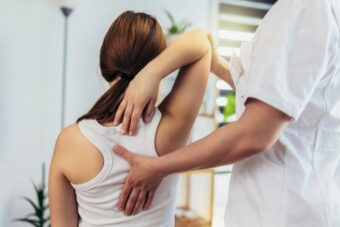 Scoliosis is a condition characterized by an abnormal lateral curvature of the spine, which can lead to pain, discomfort, and changes in posture. There are several different types of scoliosis, each with its own causes, symptoms, and treatment options. In this blog post, we will take an in-depth look at the various types of scoliosis, as well as how they are categorized based on different factors.
Scoliosis is a condition characterized by an abnormal lateral curvature of the spine, which can lead to pain, discomfort, and changes in posture. There are several different types of scoliosis, each with its own causes, symptoms, and treatment options. In this blog post, we will take an in-depth look at the various types of scoliosis, as well as how they are categorized based on different factors.
Idiopathic Scoliosis
Idiopathic scoliosis is the most common type of scoliosis and occurs in children and adolescents, with no known cause. It is further categorized based on age of onset, with infantile scoliosis (0-3 years old), juvenile scoliosis (3-10 years old), and adolescent scoliosis (10-18 years old). Idiopathic scoliosis can range from mild to severe curvature of the spine and may progress as the child grows. Treatment options for idiopathic scoliosis include observation, bracing, or surgery, depending on the severity of the condition.
Congenital Scoliosis
Congenital scoliosis is a type of scoliosis that is present at birth and is caused by abnormal development of the vertebrae in the spine. This can result in misshapen or fused vertebrae, leading to curvature of the spine. Congenital scoliosis can vary in severity and may be associated with other congenital abnormalities. Treatment for congenital scoliosis may involve observation, bracing, surgery, or a combination of these approaches, depending on the individual case.
Neuromuscular Scoliosis
Neuromuscular scoliosis is a type of scoliosis that is caused by underlying neuromuscular disorders, such as cerebral palsy, muscular dystrophy, or spinal cord injury. These conditions can affect the muscles and nerves that support the spine, leading to an abnormal curvature of the spine. Neuromuscular scoliosis tends to progress rapidly and can be associated with other health complications. Treatment for neuromuscular scoliosis may involve managing the underlying condition, physical therapy, bracing, or surgery, depending on the individual’s needs.
Degenerative Scoliosis
Degenerative scoliosis is a type of scoliosis that occurs in older adults and is usually caused by age-related changes in the spine, such as degeneration of the intervertebral discs and joints. As the spine degenerates, it can lead to a gradual curvature of the spine, often accompanied by pain and stiffness. Degenerative scoliosis can worsen over time and may be associated with other spinal conditions, such as spinal stenosis or osteoarthritis. Treatment for degenerative scoliosis may involve physical therapy, pain management, or surgery, depending on the severity of symptoms.
Functional Scoliosis
Functional scoliosis is a type of scoliosis that is caused by a temporary or reversible condition, such as muscle imbalance or leg length discrepancy. This type of scoliosis does not involve structural abnormalities in the spine but rather a secondary curvature due to external factors. Functional scoliosis may improve with corrective measures, such as physical therapy, orthotics, or chiropractic care, depending on the underlying cause. It is important to identify and address the root cause of functional scoliosis to prevent further progression.
Adolescent Idiopathic Scoliosis (AIS)
Adolescent Idiopathic Scoliosis, also known as AIS, is the most common type of scoliosis that occurs in adolescents during their growth spurt, usually between the ages of 10 to 18 years. The cause of AIS is unknown, and it is more common in females than males. AIS is typically diagnosed through a physical examination, followed by imaging studies such as X-rays or MRI to assess the severity of the curvature. Treatment options for AIS may include observation, bracing, or surgery, depending on the progression of the curvature and the individual’s age.
Adult Scoliosis
Adult scoliosis refers to scoliosis that develops or persists into adulthood, often as a result of degenerative changes in the spine or progression of untreated childhood scoliosis. Symptoms of adult scoliosis may include back pain, stiffness, and changes in posture. Treatment options for adult scoliosis may include physical therapy, pain management, or surgery, depending on the severity of symptoms and curvature. It is important for adults with scoliosis to be monitored regularly by a healthcare provider to prevent complications and manage symptoms effectively.
Summary
Scoliosis is a complex condition that can manifest in various forms, each with its own causes, symptoms, and treatment options. Understanding the different types of scoliosis and how they are categorized can help healthcare providers tailor treatment plans to meet the individual needs of patients. By accurately diagnosing and categorizing scoliosis, healthcare providers can provide appropriate interventions to manage symptoms, prevent progression, and improve quality of life for those affected by this condition.
Need a Prosthetic and Orthotic Laboratory in Farmingdale, NY?
Prothotic Labratories, Inc. is a family-owned and -operated prosthetics and orthotics specialist based in Farmingdale, New York since 1988. We offer the highest quality of products, services, and patient care for all of your prosthetic and orthotic management needs. We specialize in pediatric prosthetics, but also offer adult products and services as well, such as scoliosis management, creating custom-designed prosthetics for the upper or lower extremities, and much more. We also have extensive experience in the orthotic management of cerebral palsy, arthrogryposis, osteogenesis imperfecta, spinal muscular atrophy, and neuromuscular and idiopathic scoliosis. Give us a call today, or visit us for more information!
